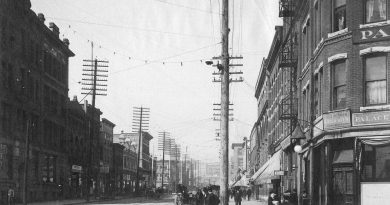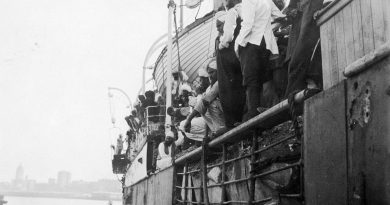Empress of Japan
Thousands of people who see the dragon figurehead of the Empress of Japan in Stanley Park think it’s the real thing, but what you see in the park today is a fibreglass copy of the original, which—battered by the elements for 80 years—was tenderly restored by conservationists at Vancouver’s Maritime Museum.
Much of what you read here is based on an article on the figurehead that appeared some years ago in an issue of the Vancouver Historical Society newsletter. The author was Leonard G. McCann, curator emeritus at the museum, and the most knowledgeable local person (by far!) on local marine history.
The Empress of Japan, McCann reminds us, is “one of the trio of the Canadian Pacific Railway Company’s first generation of ‘White Empresses,’ those ships that were the company’s final links in its drive to create an extension of its trans-Canada railway system right through to the Orient and Australasia . . . This ship was once Vancouver’s one and major link with the Orient—a ship so lovely in appearance that school children used to be taken down to see her pass in and out of the harbor on her regular schedule, a schedule that was maintained from 1891 to 1922.”
The Empress was built in Barrow, England, and arrived in Vancouver on June 22, 1891. By the time the CPR retired her in 1922, she had crossed the Pacific 315 times—setting trans-Pacific speed records that were unchallenged during 22 years of her active career—and steamed more than four million kilometres (2.5 million miles.)
“She swung at anchor in Vancouver Harbor for four years, 1922 to 1926,” McCann writes. “She was finally purchased abroad but scrapped locally, being beached in the mud on the north shore of Burrard Inlet where more than two years were spent in taking her apart. Dismaying tales are told about indifferent workmen tearing off wall hangings (which had been left on her) for use as rags, and of mahogany panelling being cast overboard into the water.
“A few sentimental and historically-minded Vancouverites descended on the wreckage to salvage what they could—thus there is a house in West Vancouver that has some of her leaded-glass bookcases installed in its den; there is another in Shaughnessy that possesses some portions of her staircase; a commercial building in North Vancouver had some of her pressed-tin ceiling panels installed in its own ceiling (the building has gone now), and some of her painted glass salon windows are feature pieces in private hands.”
And the figurehead? It was dumped, along with its 18-foot (5.5 metre) trailboards and left for destruction.
But not for long. Frank Burd, publisher of The Daily Province at the time, learned of the figurehead’s disposal and, with a handful of like-minded people, decided to rescue it. “It has been rumored,” says McCann’s article, “that a number of reporters of the Province of that day suddenly found themselves with a rather different assignment: scavenging a dump for pieces of a large wood carving and removing same.”
The dragon was found and, with the co-operation of the park board, the Province was able to install it on a concrete pedestal overlooking the First Narrows entrance to the harbor. A plaque was attached, stating the figurehead was a gift to the citizens of Vancouver. It was November, 1927.
There it sat, for decades, neglected except for an occasional slap of paint—paint that bore no relationship to the dragon’s original color. As the years passed, the figurehead began to fall apart again. This time, Norman Hacking, long-time marine editor of the Province, became involved. The result was the removal of the figurehead and its replacement in 1960 with the fibreglass copy. (After nearly 50 years, the copy itself is starting to look a bit haggard.) The original sat in the back of the works yard at Stanley Park for a time, then finally was taken to the warmth and security of the Maritime Museum basement, where it lay uncared for for 14 years.
![Empress of Japan figurehead
{Image: Wikimedia Commons]](https://vancouverhistory.ca/wp-content/uploads/2021/01/Empress_figurehead_2006-300x225.jpg)
{Image: Wikimedia Commons]
In 1974, finally, work began to restore it. The dragon was moved “for the first time with care, interest and respect,” McCann writes, “to the laboratory of the conservation division that serves the three institutions that make up the museums complex, (with) Roy Waterman as chief conservator and Marle-Noel Challan-Beval as assistant.”
They had their work cut out for them. Literally. The core of the figurehead was completely taken out (it was infested with dry rot, wet rot, carpenter ants, etc.) and all the various layers of mis-colored paint were carefully removed. One advantage of the removal of the core is that the figurehead’s immense weight was reduced. This made it easier to work on.
“Then there will come a time,” McCann’s article continues, “of trying to assemble (approximately) this gigantic, three-dimensional jigsaw puzzle so as to see what actually is missing . . . Based on the pattern and flow of the design of the remaining structure and on detailed enlargements from old photographs, replacement pieces will be created to fill the voids.
“It is the expectation of the Vancouver Maritime Museum that it will mark the centenary of the CPR (February of 1981) with a special exhibition—and that pride of place will be given to the restored figurehead of the first Empress of Japan.”
Today, visitors to the Museum are able to admire at leisure this big, colorful and dramatic piece of local marine history.

![RMS Empress of Japan in original appearance [Image: Wikipedia]](https://vancouverhistory.ca/wp-content/uploads/2021/01/1280px-Empress_of_Japan_docked_at_Vancouver_circa_1930s-800x445.jpg)


